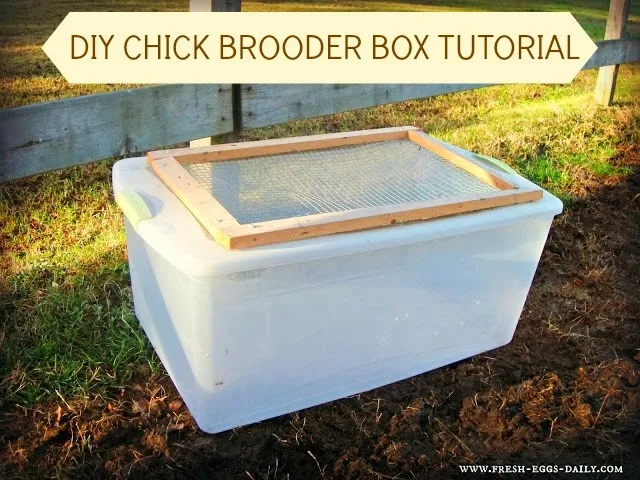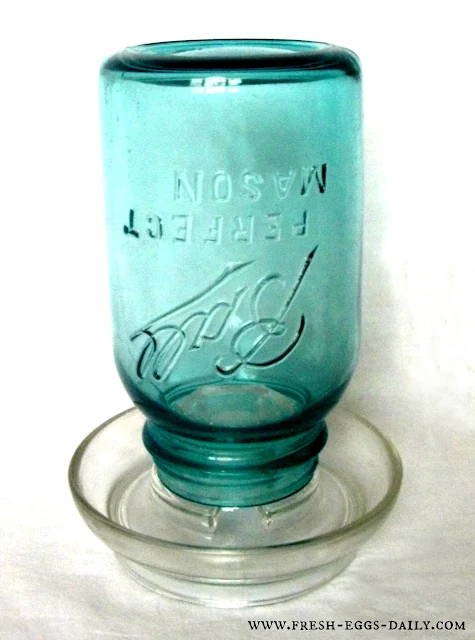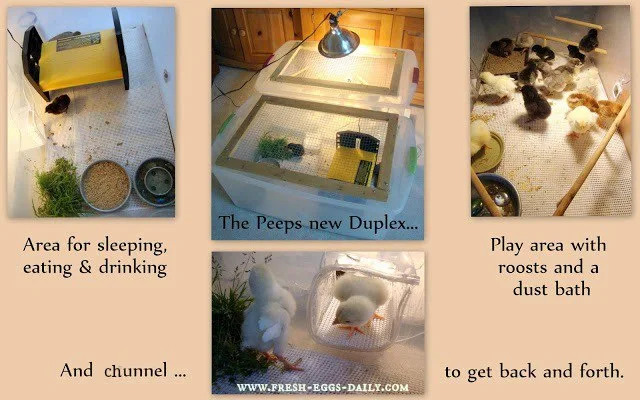Make a Plastic Tote Brooder Box for Chicks
Baby chicks need a safe warm place to spend their first few weeks after you bring them home. It's called a "brooder" or "brooder box".
I have tried brooding chicks in lots of things - plastic kiddie pools (they quickly learn to fly out) galvanized tubs (snakes can get in, don't ask!), cardboard boxes (they get wet and I worry about the fire hazard from the heat lamp).
Make a Plastic Tote Brooder Box for Chicks
I finally settled on making my own brooder box out of a plastic storage tote. It's quick and easy to make, inexpensive, durable, 100% safe, easy to clean and reusable.
A large plastic tote makes an inexpensive and safe brooder for your baby chicks when you first bring the home. You just need to make some alterations to it before your chicks move in.
Plastic Tote Brooder Box for Chicks
What you Need |
- Large covered opaque plastic storage tote (buy the largest you can find at Target, Lowes, Walmart, etc)
- Furring strip or other thin wooden board (approximately 8 feet long)
- Piece of 1/2" hardware cloth slightly smaller than the top of the plastic tote
- 8 Nuts and bolts
- Jigsaw
- Cordless drill
- Box Cutter
- Pliers
- Screw Driver
- Wire Cutters
- Dowel
- Small nails and screws
What you Do |
1. Cut a window in the lid of the tote, leaving a frame of about 2" all the way around with the box cutter. I drew the outline using a Sharpie and then scored the plastic first with the box cutter before trying to cut all the way through (don't worry, it doesn't have to be perfect).
2. Using the wire cutters, trim the hardware cloth to a size about 1" larger than the opening you just cut in the plastic lid.
3. Using the jigsaw, cut four pieces of the furring strip to form a frame the same size at the hardware cloth, then pre-drill a hole in either end of each strip.
4. Sandwich the hardware cloth in between the tote cover and furring strips and then thread a bolt through each hole and secure with a nut using the screwdriver and pliers.
5. Cut the dowel to make some miniature roosts (use small nails to attach the legs) and use small screws drilled through the side of the tote into the ends of each dowel to secure them in place.
And voila! Your baby chicks have a nice safe place to live.
From underneath, the top should look like this:
And from the top, your lid will look like this:
Brooder Box Feeder and Waterer
Your chicks will need chick-sized feeders and waterers.Placing small stones or marbles in the waterer will ensure no unfortunate drownings. A small dish of chick-sized grit is necessary to help the chicks grind up and digest any food you feed them other than chick starter feed.
Feed and water should be offered 24/7 for at least the first few weeks so the chicks can eat and drink as necessary. Treats such as herbs, weeds or soft scrambled eggs or oatmeal can be introduced slowly.
Brooder Box Heat
A heat lamp with a clamp (and preferably with a red bulb) or Brinsea Eco Glow is needed to keep the brooder a toasty 95 degrees the first week and then 5 degrees cooler each subsequent week until the chicks are feathered out - around seven to eight weeks old - and the temperature is around 60 degrees, at which point they can be moved outside full time.
Or you can remove the heat at that point and keep them in the house or garage for a bit longer if you live in a colder climate.
 |
Brooder Box Substrate
Newspaper can be too slippery for little chick feet and can cause spraddle leg, so I use several layers of newsprint covered with a sheet of rubber shelf liner for a non-slip surface of the brooder. The shelf liner is easy to remove, rinse off and reuse.
Pine shavings or chips can be added to the floor of the brooder after the first several days once the chicks figure out what is food and what isn't (never use cedar shavings, which can be toxic).
You can also use shredded paper, shredded newsprint, straw or even dried leaves. Personally, I now love to use dirt as a substrate in my brooder. It's less dusty than shavings, free and the chicks love it.
While you might have read it's okay and might be tempted because it seems easy, DO NOT use sand in your brooder. The chicks will eat it which can seriously deprive them of nutrients if they fill up on the sand and don't eat enough of their feed.
Even worse, sand can become sodden and stuck in their crops causing impacted crop which can kill them. When they poop in sand, the sand will 'bread' the poop and there's a good chance they'll eat that also which can be extremely detrimental to their health.

Your chicks will love their brooder. Placed in a quiet part of the house - we usually use our laundry room or guest bathroom - the chicks are safe from our curious cat and playful puppy.
The opaque sides allow them to peer through the tote to get used to the big world outside their sanctuary.
I think the older hens somehow know what it means when the brooder comes out of the barn and gets dusted off!
The tote works for a handful of chicks best, any more and you might need to build them a duplex.
To make the duplex, I merely cut a hole in the side of each of two totes and then connected them using a 'chunnel', a tunnel I made by cutting the top and bottom off a clear plastic container and then putting slit rubber tubing over the rough edges once I had pushed the container through the hole in each tote.
I had a heat lamp set up over one tote and the Brinsea Eco-Glow in the other so the chicks were warm not matter which tote they were in.
For more on successfully brooding and raising chicks, as well as more photos of the brooder box set-up read HERE.





























